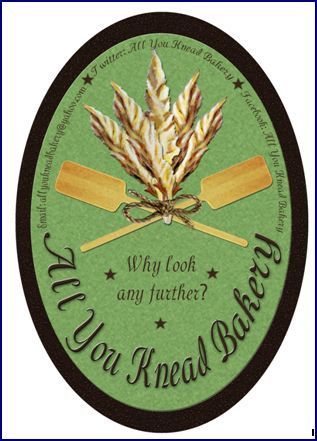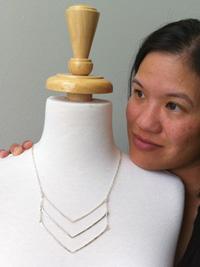 Entrepreneurship is in my blood. Both of my parents are business owners and I grew up doing my homework in quiet corners of their offices, eventually working for each of them during the summer until I graduated from college. My mom owned a catering company which grew to include an upscale restaurant, which became a second home to me during my formative years, and though I didn't know it at the time, I was learning some business lessons via observation and "immersion" that I still use today .
Entrepreneurship is in my blood. Both of my parents are business owners and I grew up doing my homework in quiet corners of their offices, eventually working for each of them during the summer until I graduated from college. My mom owned a catering company which grew to include an upscale restaurant, which became a second home to me during my formative years, and though I didn't know it at the time, I was learning some business lessons via observation and "immersion" that I still use today .
As many chefs are, my mother is and was a perfectionist. Not only did the food have to taste amazing, but the presentation had to be just right - impeccable - because it was all part of the experience. This was easy enough to do when my mom was the one cooking and plating each meal, along with a small and trusted team. That said, like many an entrepreneur, as her business grew so did her team, and that meant that she had to take herself out of the kitchen/presentation process more and more and trust others to do these things while she managed her burgeoning business and team.
If you've ever let someone else take care of your business that you worked on solo for so long, or take over a role you once did on your own, you know how scary this can be. Sure, you've picked out a team that you trust and who are enthused about and clear on your company's style and mission, but it's still hard to let go and let them do what they need to do! As I've been an entrepreneur for nearly a decade, I've been in this situation before and fortunately could turn to my mom for advice. Her advice? "You have to tell them where to put the parsely!" HUH? Let my mom explain:
When I was plating some of our entrees, I would tell someone on the line "now garnish the plate with parsley and sauce". When the plate came back to me it was nothing like I expected or wanted. Parsley and sauce were scattered here and there and I was upset beacuse it wasn't my style and what I expected. I wanted the parsely around the edge "just so". I wanted the sauce to go in a specific place. I wanted the rest of the white plate to be cleaned with a napkin so that the presentation was perfect. When it didn't look like what my perfect was I got upset, but then I realized, "I hadn't told them where to put the parsely, I just told them to do it". How could anyone know how, what or where I wanted it done without me showing and telling them specifically." Without giving them the specifics more time (not to mention plates) was wasted than was necessary.
Ah yes, the parsley. What is your parsley? What are you telling your employees or freelancers or interns to do? Are you giving them feedback and guidance in a "rushed entrepreneur style", not giving ample time or directions? Are you aware this will cause you more stress and waste more time in the long run? Or maybe you're taking the time to give them directions, but not the best or most complete set. Just like my mom learned that her employees aren't mind readers and that even those who perform at the highest level still need to be equipped with the proper tools and guidelines.
Another bonus in terms of establishing clear instructions, directions and rules? Each decision you make and every set of guidelines you share that is executed by your team the correct way helps to create your company culture and the overall customer experience. Pretty major stuff! Not things that should be taking lightly or rushed through.
In order to help you ensure your "parsley always falls in the right place", we've got a list of musts you should commit to memory when giving instructions (whether in person or virutally) to your team.
How to Give Directions at Work the Right Way
Be Specific: Simply saying "Save the document at the end of the day and we'll work on it again tomorrow." isn't enough. You need to tell them the where's, how's, etc. "Save the smoothie recipe e-book we're working on when you leave at the end of the day. Save it as 'Summer Smoothies Recipes Version 1' inside the 'Smoothie Projects' folder which you can find on your computer's desktop".
Don't Assume: You know the saying, "When you assume you make an ass out of you and me." There, I said it. I don't think anyone is an ass in this situation, but I do think it's dangerous (and time consuming) to assume people will just "get what you mean" when you introduce any new task or idea without a discussion about what the project is and what exactly you want done so that the outcome will be up to your standards.
Give Directions with Eye Contact in a Focused Conversation: If you are giving someone directions and you're in the same room with them, don't expect them to absorb them fully if either of you is typing up an email, texting, Instagramming or is focused on another project. Instead, set specific times of the day or week to stop everything else you're doing an go through the directions and expectations for a new project. This also lets them prepare any question about said project and bring the to the meeting. Employees or team members work remotely? No worries! Tap into software like Goto Meeting and you'll be able to speak with anyone, anywhere and hold your meeting face-to-face via the Internet.
Don't Just Give Directions, Share the Project Fits into the Bigger Picture:
What is the mission that these directions are trying to accomplish? Simply saying "Do A, B and then C" isn't always enough when telling someone on your team what they need to get done. I also like to share with them why we are doing something because it helps make what they are doing more real and less like a random puzzle piece. Giving them the full picture helps show them where their piece fits into the puzzle as a whole. "We're having you link the content in our blog to podcasts with similar subjects, resources and past blogs so that the reader can access more information that pertains to what they are reading about, thus learning more. It will also help them discover more and more of our brand's offerings and content." Not only does this result in a job done more efficiently, but it could even get you new insight into what you are trying to accomplish.
Don't Just Say...Show
Whether you are showing someone how to write an email, pack a delivery box, order a shipment of office supplies or post tweets to your company's Hootsuite account, if a picture is worth a thousand words a demonstration is worth ten thousand! Do it once with them watching you, bonus points if you have them then do it back in front of you. This way you can work out the kinds and be a model of what to do and what not to do! This will not only save all parties time in the future but will help your employee feel more confident and move more quickly when they do it on their own.
Anticipate & Discuss Challenges & Hiccups
Even the best laid and strategized plans can go awry. As someone who has been doing many of your company's tasks for years you have seen and experienced the big and small challenges that pop up from time to time. You're able to anticipate what speed bumps one may encounter along the way. Think about those before you give your directions and discuss them with your employees before they begin a project.
Just as my mom has always stressed the importance of "knowing where to put the parsley", she's also been a big proponent of educating oneself as an entrepreneur about business and employee management success strategies. No matter what your prior professional background, there is no excuse for not taking the time to learn how to run your business well! After all, the rules in business are very similar to those in life, and one of the biggies in each is "clear and open communication". Use the strategies above to make managing your team, delegating and giving instructions easier and more productive.
Have any other tips for giving great directions? Share them in the comments below!
 Submitted by Ashley Cox on | 1 Comments
Submitted by Ashley Cox on | 1 Comments
 All garments are made in the United States but, are available nationwide and internationally. Twice a year LympheDIVAs team studies the trends, patterns, and colors of the fashion industry to introduce new garments that encourage each woman to feel beautiful, strong, and confident while improving the management of lymphedema. Rachel may have been defeated by her physical battle of cancer but, her vision and passion remains undefeated and undoubtedly empowers many individuals with dignity, respect, and motivation.
All garments are made in the United States but, are available nationwide and internationally. Twice a year LympheDIVAs team studies the trends, patterns, and colors of the fashion industry to introduce new garments that encourage each woman to feel beautiful, strong, and confident while improving the management of lymphedema. Rachel may have been defeated by her physical battle of cancer but, her vision and passion remains undefeated and undoubtedly empowers many individuals with dignity, respect, and motivation.





 Here at Tin Shingle we’re always giddy with delight when new members join, but when
Here at Tin Shingle we’re always giddy with delight when new members join, but when 


 Entrepreneurship is in my blood. Both of my parents are business owners and I grew up doing my homework in quiet corners of their offices, eventually working for each of them during the summer until I graduated from college. My mom owned a catering company which grew to include an upscale restaurant, which became a second home to me during my formative years, and though I didn't know it at the time, I was learning some business lessons via observation and "immersion" that I still use today .
Entrepreneurship is in my blood. Both of my parents are business owners and I grew up doing my homework in quiet corners of their offices, eventually working for each of them during the summer until I graduated from college. My mom owned a catering company which grew to include an upscale restaurant, which became a second home to me during my formative years, and though I didn't know it at the time, I was learning some business lessons via observation and "immersion" that I still use today .  One of the most daunting things about PR is the amount of your time it can consume - time you could fill doing one of several (hundred) items on your business owner To Do List. The time you could spend doing your own publicity outreach and the opportunities and ways you can share your brand are often limited only by the lack of hours you have available in a day to "work it", it being your PR plan.
One of the most daunting things about PR is the amount of your time it can consume - time you could fill doing one of several (hundred) items on your business owner To Do List. The time you could spend doing your own publicity outreach and the opportunities and ways you can share your brand are often limited only by the lack of hours you have available in a day to "work it", it being your PR plan. When the baker gave two weeks notice for his retirement at
When the baker gave two weeks notice for his retirement at 

 I’m always on the lookout for a unique opportunity to promote my jewelry,
I’m always on the lookout for a unique opportunity to promote my jewelry,  I didn’t turn up a direct email, however. So more sleuthing was required – I scouted the SI website and the profiles of other SI writers (on Twitter, on LinkedIn) to see what the email conventions were. I could have also contacted her via LinkedIn, but I preferred being able to send an email. After scouting Sports Illustrated info, I pieced together what the email address would likely be and crafted my pitch. I also
I didn’t turn up a direct email, however. So more sleuthing was required – I scouted the SI website and the profiles of other SI writers (on Twitter, on LinkedIn) to see what the email conventions were. I could have also contacted her via LinkedIn, but I preferred being able to send an email. After scouting Sports Illustrated info, I pieced together what the email address would likely be and crafted my pitch. I also 
 For many of us, March has come in like a lion (brrr) which is how I'd like you to visualize yourself when pitching your business this March - YOU ARE A LION, a pitching LION (or Lioness). You are hunting after hot stories because you have a plan, ideas and creative angles.
For many of us, March has come in like a lion (brrr) which is how I'd like you to visualize yourself when pitching your business this March - YOU ARE A LION, a pitching LION (or Lioness). You are hunting after hot stories because you have a plan, ideas and creative angles. 





